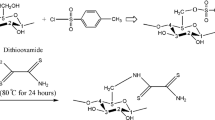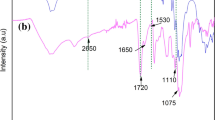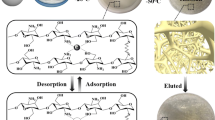Abstract
Novel surface copper ion-imprinted bacterial cellulose nanofiber nonwoven adsorbent was fabricated via surface ion-imprinting technique combined with electrospinning technology for highly selective adsorption of copper ions in aqueous solutions. The as-prepared nanofiber nonwoven adsorbent was characterized by scanning electron microscopy, specific surface area, Fourier transform infrared spectroscopy and energy dispersive X-ray, respectively. The adsorption capacity and recognition selectivity performance towards copper ions were investigated by batch experiments. The experimental data indicate that the ion-imprinted nanofiber nonwoven adsorbent presents excellent adsorption ability and high recognition selectivity towards copper ions in binary systems using zinc, nickel, lead and cadmium as competitive ions. The maximum copper ion adsorption capacity is determined to be 152.2 mg/g at 298 K, which is higher than that of the other imprinted adsorbents. The selectivity coefficients for copper ion adsorption in binary metal ion solution of copper/zinc, copper/nickel, copper/lead and copper/cadmium reach up to 47, 101, and 162, respectively. As illustrated by Scatchard models, the specific recognition site with high copper ion affinity should be a key factor affecting selective adsorption. In addition, the nanofiber nonwoven adsorbent exhibits good anti-interference ability and reusability. The nanofiber nonwoven adsorbent can be reused at least ten cycles with only 7.9% reduction in adsorption capacity. Therefore, the prepared copper ion-imprinted nanofiber nonwoven can be an effective adsorbent for separation or enrichment of copper ions for water treatment applications.
Graphical abstract












Similar content being viewed by others
References
Abdi J, Vossoughi M, Mahmoodi NM, Alemzadeh I (2017) Synthesis of amine-modified zeolitic imidazolate framework-8, ultrasound-assisted dye removal and modeling. Ultrason Sonnchem 39:550–564
Bakhshpour M, Tamahkar E, Anda M, Denizli A (2017) Surface imprinted bacterial cellulose nanofibers for hemoglobin purification. Coll Surf B 158:453–459
Bashir A, Malik LA, Ahad S, Manzoor T, Bhat MA, Dar GN (2019) Removal of heavy metal ions from aqueous system by ion-exchange and biosorption methods. Environ Chem Lett 17:729–754
Bhagat SK, Tung TM, Yaseen ZM (2020) Development of artificial intelligence for modeling wastewater heavy metal removal: state of the art, application assessment and possible future research. J Clean Prod 250:119473
Cai XQ, Li JH, Zhang Z, Yang FF, Dong RC, Chen LX (2014) Novel Pb2+ ion imprinted polymers based on ionic interaction via synergy of dual functional monomers for selective solid-phase extraction of Pb2+ in water samples. Appl Mater Interfaces 6:305–313
Chen CY, Yang CY, Chen AH (2011) Biosorption of Cu(II), Zn(II), Ni(II) and Pb(II) ions by crosslinked metal-imprinted chitosans with epichlorohydrin. J Environ Manag 92:796–802
Chen Q, Yao Y, Li X, Lu J, Zhou J, Huang Z (2018) Comparison of heavy metal removals from aqueous solutions by chemical precipitation and characteristics of precipitates. J Water Process Eng 26:289–300
Chen X, Cui J, Xu X, Sun B, Sun D (2019) Bacterial cellulose/attapulgite magnetic composites as an efficient adsorbent for heavy metal ions and dye treatment. Carbohydr Polym 229:115512
Davarpanah S, Mahmoodi NM, Arami M, Bahrami H, Mazaheri F (2009) Environmentally friendly surface modification of silk fiber: chitosan grafting and dyeing. Appl Surf Sci 255:4171–4176
Duan JX, Li X, Zhang CC (2017) The synthesis and adsorption performance of polyamine Cu2+ imprinted polymer for selective removal of Cu2+. Polym Bull 74:3487–3504
Emel T, Monireh B, Adil D (2019) Molecularly imprinted composite bacterial cellulose nanofibers for antibiotic release. J Biomat Sci Polym E 30(6):450–461
Erol K, Uzun L (2017) Two-step polymerization approach for synthesis of macroporous surface ion-imprinted cryogels. J Macromol Sci A 54(11):867–875
Fang Q, Zhou X, Deng W, Zheng Z, Liu Z (2016) Freestanding bacterial cellulose-graphene oxide composite membranes with high mechanical strength for selective ion permeation. Sci Rep 6(1):33185
He HX, Gan Q, Feng CG (2018) An ion-imprinted silica gel polymer prepared by surface imprinting technique combined with aqueous solution polymerization for selective adsorption of Ni(II) from aqueous solution. Chin J Polym Sci 36:51–60
Hoai NT, Yoo D, Kim D (2010) Batch and column separation characteristics of copper-imprinted porous polymer micro-beads synthesized by a direct imprinting method. J Hazard Mater 173:462–467
Hong HJ, Lim JS, Hwang JY, Kim M, Jeong HS, Park MS (2018) Carboxymethlyated cellulose nanofibrils(CMCNFS) embedded in polyurethane foam as a modular adsorbent of heavy metal ions. Carbohydr Polym 195:136–142
Hou Y, Wang X, Yang J, Zhu R, Li Y (2018) Development and biocompatibility evaluation of biodegradable bacterial cellulose as a novel peripheral nerve scaffold. J Biomed Mater Res A 106:1288–1298
Janmohammadi M, Nourbakhsh MS (2018) Electrospun polycaprolactone scaffolds for tissue engineering: a review. Int J Polym Mater Po 68:1–13
Jiajia W, Zhanwen D, Ping X, Zhijiang C (2020) Fabrication of flexible polyindole/carbon nanotube/bacterial cellulose nanofiber nonwoven electrode doped by D-tartaric acid with high electrochemical performance. Cellulose 27:6353–6366
Kashefi S, Borghei SM, Mahmoodi NM (2019) Covalently immobilized laccase onto graphene oxide nanosheets: preparation, characterization, and biodegradation of azo dyes in colored wastewater. J Mol Liq 276:153–162
Kim T, Kim TK, Zoh KD (2020) Removal mechanism of heavy metal (Cu, Ni, Zn, and Cr) in the presence of cyanide during electrocoagulation using Fe and Al electrodes. J Water Process Eng. 33:101109
Li Z, Tian H, Yuan Y, Yin X, Wei X, Tang L et al (2019) Metal-ion-imprinted thermo-responsive materials obtained from bacterial cellulose: synthesis, characterization, and adsorption evaluation. J Mater Chem A 7:11742–11755
Mahmoodi NM (2014) Binary catalyst system dye degradation using photocatalysis. Fiber Polym 15(2):273–280
Mahmoodi NM, Arami M, Limaee NY, Gharanjig K, Nourmohammadian F (2007) Nanophotocatalysis using immobilized titanium dioxide nanoparticle: degradation and mineralization of water containing organic pollutant—case study of Butachlor. Mater Res Bull 42:797–806
Miao YE, Zhu GN, Hou H, Xia YY, Liu T (2013) Electrospun polyimide nanofiber-based nonwoven separators for lithium-ion batteries. J Power Sources 226:82–86
Mishra S, Verma N (2017) Surface ion imprinting-mediated carbon nanofiber-grafted highly porous polymeric beads: synthesis and application towards selective removal of aqueous Pb(II). Chem Eng J 313:1142–1151
Monier M, Abdel-Latif DA (2013) Synthesis and characterization of ion-imprinted resin based on carboxymethyl cellulose for selective removal of Uo22+. Carbohydr Polym 97:743–752
Mousavi S, Deuber F, Petrozzi S, Federer L, Aliabadi M, Shahraki F, Adlhart C (2018) Efficient dye adsorption by highly porous nanofiber aerogels. Colloid Surf A 547:117–125
Nasrollahi N, Aber S, Vatanpour V, Mahmoodi NM (2019) Development of hydrophilic microporous PES ultrafiltration membrane containing CuO nanoparticles with improved antifouling and separation performance. Mater Chem Phys 222:338–350
Ngah WSW, Teong LC, Hanafiah MAKM (2011) Adsorption of dyes and heavy metal ions by chitosan composites: a review. Carbohydr Polym 83:1446–1456
Pang Y, Zeng GM, Tang L, Zhang Y, Liu YY, Lei XX, Li Z, Zhang JC, Xie GX (2011) PEI-grafted magnetic porous powder for highly effective adsorption of heavy metal ions. Desalination 281:278–284
Peng W, Xie ZZ, Cheng G, Shi L, Zhang YB (2015) Amino-functionalized adsorbent prepared by means of Cu(II) imprinted method and its selective removal of copper from aqueous solutions. J Hazard Mater 294:9–16
Quan F, Dingsheng W, Yong Z, Anfang W, Qufu W, Hao F (2018) Electrospun AOPAN/RC blend nanofiber membrane for efficient removal of heavy metal ions from water. J Hazard Mater 344:819–828
Ren ZQ, Zhu XY, Du J, Kong DL, Wang N, Wang Z, Wang Q, Liu W, Li QS, Zhou ZY (2018) Facile and green preparation of novel adsorption materials by combining sol-gel with ion imprinting technology for selective removal of Cu(II) ions from aqueous solution. Appl Surf Sci 435:574–584
Roushani M, Abbasi S, Khani H (2015) Synthesis and application of ion-imprinted polymer nanoparticles for the extraction and preconcentration of copper ions in environmental water samples. Environ Monit Assess 187:601–610
Skoczko I, Szatyłowicz E (2018) Removal of heavy metal ions by filtration on activated alumina-assisted magnetic field. Desalin Water Treat 117:345–352
Süreyya M, Guida M, Anselmo A, Mattei ML, Pagano G (2002) Microbial and cod removal in a municipal wastewater treatment plant using coagulation flocculation process. Envion Lett 37:1483–1494
Tripathy S, Bhandari V, Sharma P, Vanjari SRK, Singh SG (2019) Chemiresistive DNA hybridization sensor with electrospun nanofibers: a method to minimize inter-device variability. Biosens Bioelectron 133:24–31
Wang B, Bai Z, Jiang H, Prinsen P, Luque R, Zhao S, Jin X (2019a) Selective heavy metal removal and water purification by microfluidically-generated chitosan microspheres: characteristics, modeling and application. J Hazard Mater 364:192–205
Wang L, Li J, Wang J, Guo X, Wang X, Choo J, Chen L (2019b) Green multi-functional monomer based ion imprinted polymers for selective removal of copper ions from aqueous solution. J Colloid Interface Sci 541:376–386
Wu GH, Song GC, Wu DY, Shen YY, Wang ZQ, He CY (2010) Synthesis of ion-imprinted mesoporous silica gel sorbent for selective adsorption of copper ions in aqueous media. Microchim Acta 171:203–209
Wu RX, Zheng GF, Li WW, Zhong LB, Zheng YM (2018) Electrospun chitosan nanofiber membrane for adsorption of Cu(II) from aqueous solution: fabrication, characterization and performance. J Nanosci Nanotechnol 18:5624–5635
Xu J, Cao Z, Zhang Y, Yuan Z, Lou Z, Xu X, Wang X (2018a) A review of functionalized carbon nanotubes and graphene for heavy metal adsorption from water: preparation, application, and mechanism. Chemsophere 195:351–364
Xu J, Chen Y, Zheng L, Liu B, Liu J, Wang X (2018b) Assessment of heavy metal pollution in the sediment of the main tributaries of dongting lake, China. Water 10:1060
Yu H, Chen X, Cai J, Ye D, Wu Y, Liu P (2018) Dual controlled release nanomicelle-in-nanofiber system for long-term antibacterial medical dressings. J Biomat Sci Polym E 30:1–25
Zhang N, Hu B, Huang C (2007) A new ion-imprinted silica gel sorbent for on-line selective solid-phase extraction of dysprosium(III) with detection by inductively coupled plasma-atomic emission spectrometry. Anal Chim Acta 597:12–18
Zhang Z, Xu X, Yan Y (2010) Kinetic and thermodynamic analysis of selective adsorption of Cs(I) by a novel surface whisker-supported ion-imprinted polymer. Desalination 263:97–106
Zhang S, Shi Q, Christodoulatos C, Korfiatis G, Meng X (2019) Adsorptive filtration of lead by electrospun PVA/PAA nanofiber membranes in a fixed-bed column. Chem Eng J 370:1262–1273
Zhao B, Jiang H, Lin Z, Xu S, Zhang A (2019) Preparation of acrylamide/acrylic acid cellulose hydrogels for the adsorption of heavy metal ions. Carbohydr Polym 224:115022
Zhijiang C, Ping X, Shiqi H, Cong Z (2019) Soy protein nanoparticles modified bacterial cellulose electrospun nanofiber membrane scaffold by ultrasound-induced self-assembly technique: characterization and cytocompatibility. Cellulose 26:6133–6150
Zhu H, Jia S, Wan T, Jia Y, Yang H, Li J, Cheng Z (2011) Biosynthesis of spherical Fe3O4/bacterial cellulose nanocomposites as adsorbents for heavy metal ions. Carbohydr Polym 86:1558–1564
Zhu Y, Bai ZS, Wang HL (2017) Microfluidic synthesis of thiourea modified chitosan microsphere of high specific surface area for heavy metal wastewater treatment. Chinese Chem Lett 28:633–641
Funding
This work was supported by Tianjin Science Technology Research Funds of China (19JCZDJC37500). We would like to thank the Analytical & Testing Center of Tiangong University for structured illumination microscopy work.
Author information
Authors and Affiliations
Corresponding author
Ethics declarations
Conflict of interest
The authors declare that they have no conflict of interest.
Additional information
Publisher's Note
Springer Nature remains neutral with regard to jurisdictional claims in published maps and institutional affiliations.
Rights and permissions
About this article
Cite this article
Xiaorui, K., Cong, Z., Pin, X. et al. Copper ion-imprinted bacterial cellulose for selectively removing heavy metal ions from aqueous solution. Cellulose 29, 4001–4019 (2022). https://doi.org/10.1007/s10570-022-04519-4
Received:
Accepted:
Published:
Issue Date:
DOI: https://doi.org/10.1007/s10570-022-04519-4




